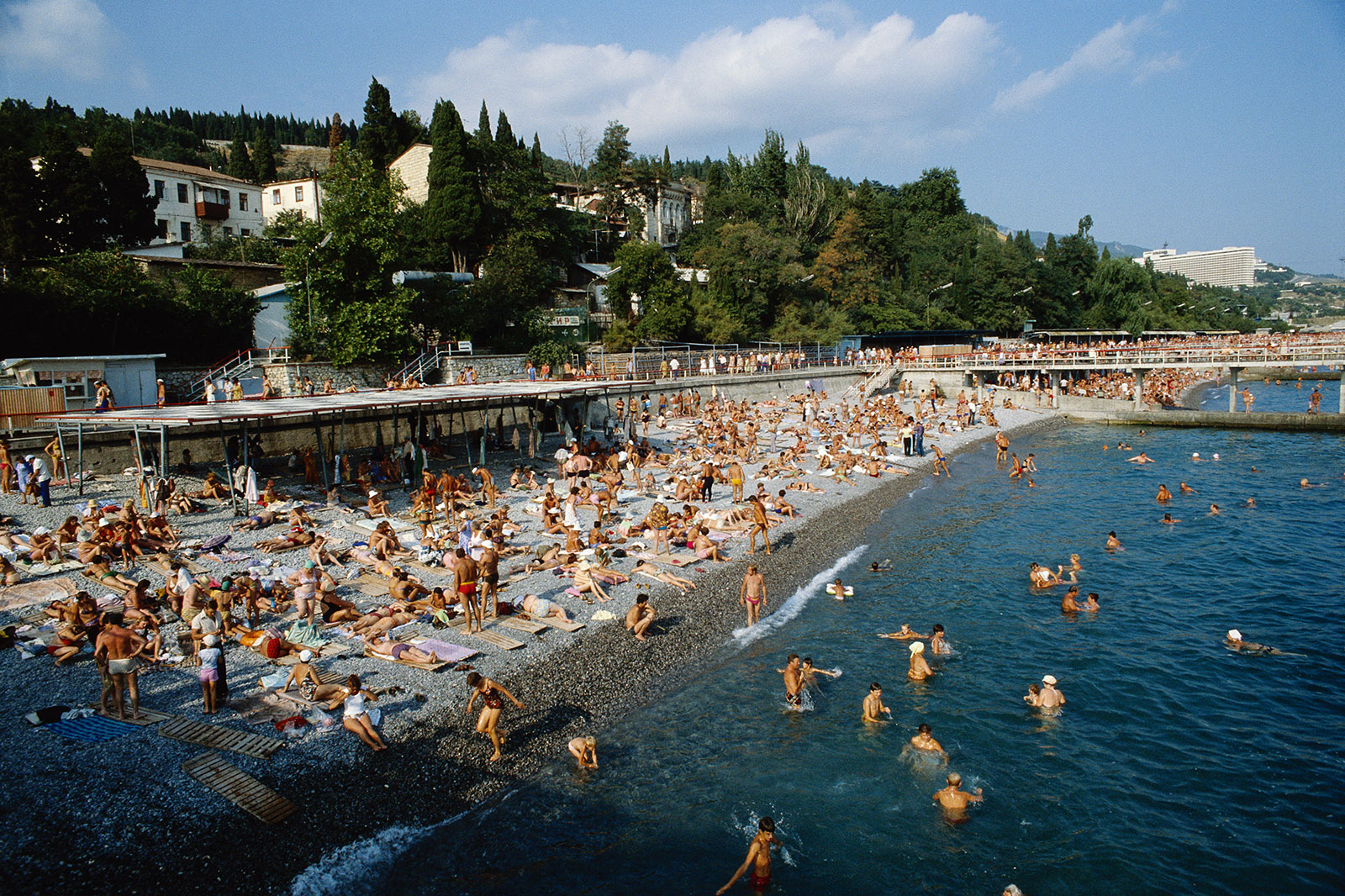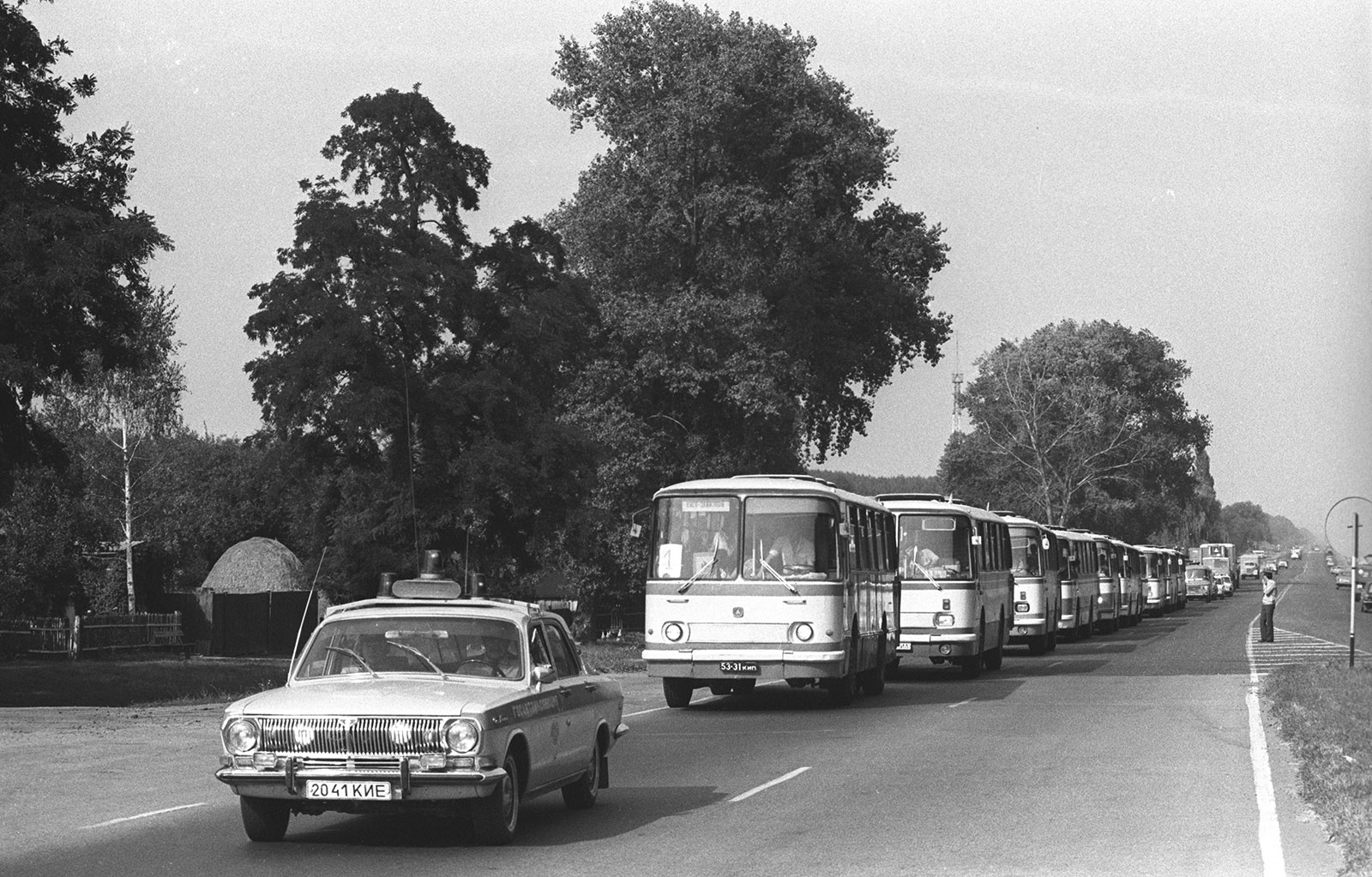The moment we arrived at the hotel “Spring” in the Black Sea resort town of Adler, we knew things were different. It was the height of the season, but our high-rise block was half-empty and the food was excellent: we had beefsteak and copious quantities of fresh vegetables and fruit. Brand new strollers and kids’ bicycles were parked near the entrance of every hotel. Rippling water brightened the normally empty mosaic splash-pools and grottos of the “Kids’ Town.” The resort management, my mother hypothesized, must be preparing for a senior Party functionary’s visit.
On the third day of our stay, already tanned and getting used to the accumulating luxuries around us that by now included movies every night, our lunch table was set for four. Black caviar sandwiches were offered as appetizers. The last time I’d had black caviar was at my grandfather’s funeral, two years earlier.
As I eyed the last two pieces, a new group was ushered into the cafeteria. They’d have looked like regular vacationers had it not been for a slightly startled expression they all shared, as though woken up in the middle of the night and never given a chance to regain their bearing. They followed the waiters obediently. Suddenly, a whisper ran through the dining hall: “Chernobylskye.” People from Chernobyl.
“Well, that explains it,” my mother said, nodding at the caviar sandwiches. “They can certainly do things right when they want to.”
*
Eight weeks earlier, on April 26, 1986, we’d paid little attention to the five-sentence announcement on the evening news about an accident at the Chernobyl power plant in the sister-republic of Ukraine. There was an accident, the injured were being helped, a government commission had been set up.
That it had happened at a nuclear plant did not register. Though we lived under a constant threat of nuclear annihilation by the United States, our nuclear energy, we were told, was the “peaceful atom,” harnessed to serve the interests of the people.
I was then in the sixth grade in school in Krasnodar, about 900 miles southeast of Chernobyl. On May 10, the Institute of Culture, where my mother worked, was giving a holiday concert at the town’s football stadium. As usual, she took me with her. I knew the program by heart—patriotic marches, folk dances, ballet numbers, gymnasts with ribbons. But the grand finale, whatever it was supposed to be that year, never came—instead, the thunderstorm that had been gathering all day finally broke loose. Ferocious torrents of rainwater started flooding the stadium’s bowl.
We were soon soaked. Like most children, I never minded the rain, but the concert-goers—about five thousand of them after free tickets had been distributed at local schools— began filing out of the stalls. It was a silent storm, with no lightning and only distant thunder, as though nature’s main focus was to drench. The rain pounded on, turning streets into a crisscross of muddy torrents; in some places, where the road dipped, the water reached up to our hips.
For the rest of the week, the whole town was talking about the “freak rain” that had ravaged so many cherry and apricot orchards, whose delicate fruits were just beginning to form. Come summer, it would cost a pretty penny to make those preserves.
My mother was more concerned about procuring our vacation vouchers to the Black Sea, always a struggle on her 140-rubles-a-month salary as a piano teacher. Finally, after much haggling and wheedling, on June 21 we boarded a forty-minute flight to Adler, the last town on the Russian side of the Abkhazian–Georgian border, where we’d vacationed over the previous two summers.
*
At the resort’s restaurant, the Chernobylskye received a mixed welcome. At a table across from ours, a bespectacled father in a checkered shirt listened dejectedly to what his wife was saying in his ear. Then he pulled aside one of the waiters.
“I have children,” I heard him say. “Do not put these contagious ones at our table.” When the waiter shrugged him off, the father engaged in negotiations with a family occupying a table next to him; they promptly abandoned their seats and, with their plates and utensils, launched themselves at his table, like soldiers blocking an enemy advance with their bodies. “Let them sit with their group,” the other father told the waiter. My mother waggled her finger around her temple, signaling cuckoo talk.
In a moment, we too got new neighbors: a woman in her early thirties and a girl of five. The mother, Varya, was of the same unremarkable appearance that our planned economy allowed the majority of women—henna-dyed hair, a shapeless sarafan with large flower print, beat-up house shoes. Her daughter, Katya, was a darling: dimpled, bright-eyed, and constantly smiling. Unlike her mother, who barely touched the food—that day, beef pilaf with plenty of meat and delicate Georgian spices—Katya ate everything: she wolfed down the remaining caviar sandwiches and accepted an extra portion of pilaf.
Advertisement
By the meal’s end, we’d learned that Varya and Katya were from Gomel, a Belarus city about eighty miles north of Chernobyl. At the beginning of June, the plant where Varya worked had started distributing free vouchers to Black Sea resorts. The sea air was healthful and healing, the plant’s management had told them, though nobody would say what they might need healing from.
After these three weeks near Sochi, she had no idea what lay in store back home. The city of Pripyat and all of the surrounding villages had been evacuated; there was a rumor that Gomel might be, too. Varya had no family outside of Belarus, so she just planned to stay put and follow the instructions: keep windows closed, stay out of the rain, do not panic. “They wouldn’t have let the kids go to the First of May demonstration if the radiation level was dangerous,” she reasoned. “They may not care about us, but they care about the kids.”
Katya and Varya went back to the hotel from the cafeteria by bus, while we walked, a pleasant forty-minute stroll along a cypress-lined path. “Poor people,” my mother said. “I wouldn’t want to go back there.” Meanwhile, I was pondering the word “radiation” that had been dropped by Katya’s mother a couple of times. This past spring, our entire school had been making a thousand paper cranes as a pledge of solidarity with a Japanese girl who’d died from radiation exposure in the aftermath of 1945 Hiroshima bombing.
Over the next few weeks, Mother made an extra effort to be nice to Varya—saving them seats on the bus, or in the shady area of the beach. I was happy: at last, I had a playmate. Striking up friendships with other kids was hard. Other families were wary of us—or the women were: a single, attractive divorcee like my mother was a red flag. So, most of the time, I played alone.
I lugged this Katya everywhere. She’d never been to the sea before, so I taught her to float on her back and to jump from the jetty, holding hands. As the days rolled by, I hated the idea of their going away. At our last dinner together, we exchanged addresses. I squeezed Katya, stroked the soft locks at the back of her head—then they were gone.
In a day, another “Chernobyl” group arrived, this time from Kiev. Unlike the Gomel group, they were put in a separate dining hall. The other guests kept complaining—some vacationers demonstratively left when “the radioactive” would enter the room.
*
By the following year, the summer of 1987, things were back to normal at the Adler resort: the food was mediocre, the air-conditioned buses used to shuttle us around the year before had disappeared, the splash pools worked only on and off. Throughout the weeks of our stay, lazy and uneventful, I wondered about Katya and her mother.
By then, Chernobyl had entered our daily lives in the strangest ways. At the market, the size of fruits or vegetables, until then a matter of pride for their growers, became a disadvantage: nobody wanted the big tomatoes or apples, for the fear they were “mutants from Chernobyl.” Forest mushrooms, small or large, were avoided altogether as “radiation sponges.” I no longer played in the rain—“Who knows what’s in it,” my mother said. In nearby Mostovskaya, construction on a new nuclear power station had stopped. At school, the wags refashioned Gogol’s “A rare bird will yet fly to the middle of the Dniepr” as “the middle of the Pripyat,” the Dniepr’s tributary that ran past Chernobyl.
On the streets, standing in the eternal lines, people blamed Gorbachev for allowing Chernobyl to happen—as they blamed him for trying to change the system that had engendered the disaster. That the newspapers no longer talked only about our “great achievements,” that sometimes the truth began to melt patches in the permafrost of lies in which we all lived, seemed to matter little. People hated him for the very reasons my mother and I liked him. He was human—not a quality Soviet citizens were accustomed to finding in their leaders. In a country built on violence, a leader not feared risks being despised.
In February of 1989, my last year of high school, I felt a small lump in my left breast. As we rode a tram to the regional hospital, I asked my mother whether Chernobyl was catching up with me. She explained it was impossible: the days after the accident, the wind had been blowing west, toward Europe, and not south, so the rainstorm on May 10 in Krasnodar couldn’t have mattered. But what I’d meant, I said, was all the time I’d spent with little Katya. What if…
Advertisement
My mother, pale, despite the confidence in her voice, ordered me to stop guessing and wait for the doctor’s opinion. She’d use the same voice to talk about my health scares for years to come; the incident turned me into a hypochondriac. During the night following the tests, as I drifted in and out of uneasy sleep, she sat silently chain-smoking in the kitchen.
The biopsy came back normal, and a second, older surgeon recommended leaving the lump alone. We celebrated by going to a cooperative café and ordering the entire chicken grill, undaunted by its twenty-seven rubles price tag.
Thirty-three years later, the Chernobyl cloud lingers. By 2003, the rate of thyroid cancer diagnosis in Gomel, Katya’s hometown, was 10,000 times higher than it had been before the disaster at Chernobyl. Birth abnormalities also spiked dramatically, and remain high decades later. It is now known that in the immediate aftermath of the accident, the radioactive contamination in some parts of Gomel were as bad as in the “exclusion zone” around the reactor, now encased in its steel-and-concrete tomb; young children were among the most affected. Yet Gomel retains its half-million population. It’s said that people will live anywhere. What they forget to say is that not everyone has a chance to leave.
At first, when my American friends began asking me about the HBO drama serial Chernobyl that aired in May, I evaded their questions. After all these years, the subject still felt too close to home and too fraught with tragedy-turned-melodrama possibilities. But when I finally watched it, what I felt was gratitude. The saga of the USSR’s technological and moral catastrophe is a stark reminder of where a road that was paved with falsehoods and grand delusions came to a dead-end. I still wonder what became of my laughing little Katya.





